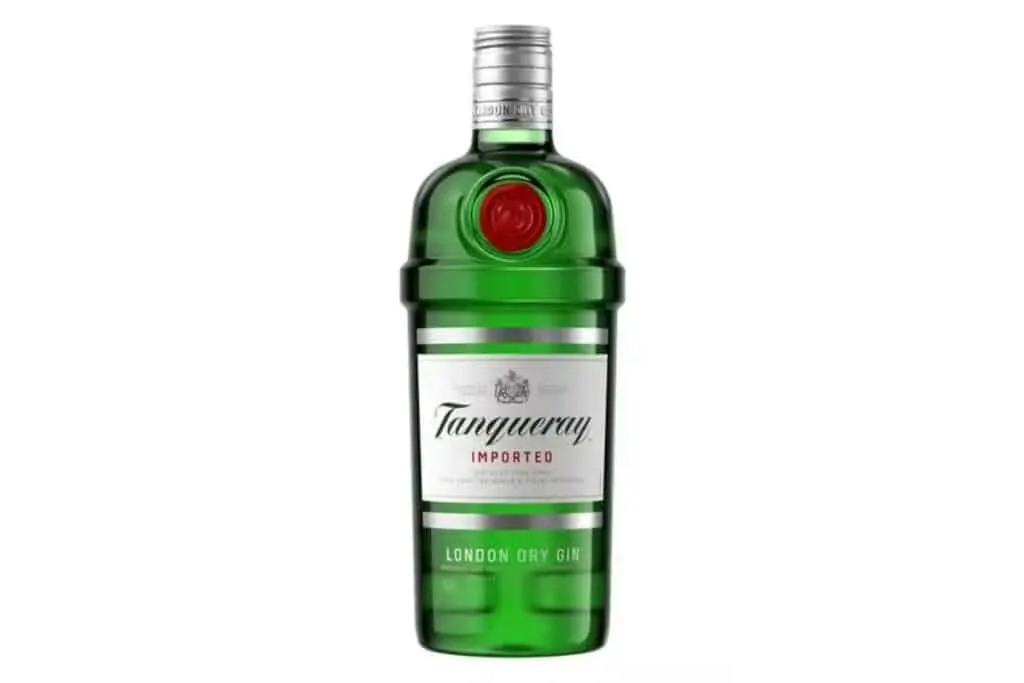First distilled in 1830 in the Bloomsbury district of London by Charles Tanqueray, Tanqueray Gin is one of the most famous London Dry Gins on the market. It is, in fact, one of the top 10 best-selling gins in the world.
This gin has a long, fascinating history, and yet the recipe has stayed the same since the first bottle was sold 200 years ago. Tanqueray Gin is made with just four botanical ingredients, proving that sometimes keeping things simple works.
Tanqueray Gin is also fortunate enough to be a Royal Warrant Holder, appointed by Her Majesty the Queen.
In this review, we’ll be taking a closer look at Tanqueray Gin, including the drink’s history, tasting notes, and its suitability in cocktails.
The History Of Tanqueray Gin
As mentioned above, Tanqueray Gin takes its name from the man who created the drink, Charles Tanqueray. Being a pastor’s son, Charles Tanqueray broke from family tradition at aged 20 and opened his Vine Street Distillery in Bloomsbury, an area that was famed for its high quality water.
After experimenting with various botanical ingredients from around the world, Charles landed on four ingredients that would make up the recipe for Tanqueray Gin.
Whilst the recipe is a closely guarded secret, the four known botanicals in every bottle of Tanqueray Gin are Coriander, Juniper, Angelica, and Licorice.
Before World War II, Tanqueray merged with Gordon’s to become Tanqueray Gordon & Co and moved to their distillery.
This facility was later badly damaged during air raids and the only surviving distillery, known as “Old Tom” was moved to Cameron Bridge, Scotland.
Tanqueray London Dry Gin

The Distilling Process
As written on the label of every bottle of Tanqueray Gin, this gin goes through the distilling process four times. The Cameron Bridge Distillery in Scotland is famous for being an all-in-one distillery.
Whilst other manufacturers bring the base of the drink in from a third party, Tanqueray Gin’s wheat-neutral-spirit base is made on site. This allows for a greater level of consistency before infusing the botanical ingredients.
Two types of water are used in the distillation process, which adds depth to the profile of flavors. The first water is extracted from a well on the grounds of the distillery.
The second is demineralized water. Blending these two types of water is meant to mirror the Bloomsbury water used in the original recipe.
The “One-Shot” method is employed during the four-step distillation process, which is hard to find outside of boutique distilleries.
Starting as a neutral spirit, the botanical ingredients are steeped and added. Just before bottling, the spirit is cut with the blended water to bring it to the correct proof.
On the bottle you’ll find a red wax seal which is said to represent the Tanqueray family crest and also acts as a seal of quality.
The bottle itself has the classic green hue to it which has almost become synonymous with Tanqueray Gin. A pineapple with two axes can be found printed on the top of the cap of each bottle.
In the 1800s, pineapples were seen as symbols of both prosperity and hospitality.
It is believed that the two axes on either side of the pineapple are connected to the Tanqueray family’s involvement in the third crusade.
Tasting Notes Of Tanqueray Gin
Tanqueray Gin is a true London Dry Gin. As it is not made with citrus, it is much drier than other gins in the same league. That being said, it is remarkably smooth on the palate. The four botanicals are perfectly balanced, meaning that one does not overpower the other.
On the nose, the mainstay is Juniper, and is the predominant note. In fact, no other gin has managed to get that singular punch of juniper.
There is a hint of imitation citrus zest, imitation because citrus isn’t one of the ingredients in Tanqueray Gin.
The punch of Juniper and imitation citrus notes are rounded off with angelica stalk and aniseed thanks to the licorice.
In terms of flavor, much like on the nose, it starts with juniper. Moving through to hints of citrus and finishing on a rich baking spice involving angelica root, coriander seed, and cinnamon. The finish on this gin is slightly warming and spice-forward.
Tanqueray Gin In Cocktails
Being one of the most popular and widely available gins in the world has its benefits.
Walk into any bar around the world and chances are they’ll have a bottle of Tanqueray Dry London Gin on the back shelf.
If you’re after a no nonsense Gin and Tonic, Tanqueray Gin is arguably the best choice. Serve with premium tonic water for the best experience.
Simply add 50ml of Tanqueray London Dry Gin to a glass with plenty of ice, good quality tonic water, and a lime wedge, stir and enjoy.
If you’re looking for something a little more extravagant, Tanqueray London Dry Gin works wonderfully in a French 75. The French 75 is a light cocktail that has plenty of panache.
You’ll need a cocktail shaker to really get the most out of each of the ingredients.
However, if you don’t have one, then stirring or using two glasses to mix the ingredients might work.
You’ll need the following ingredients to make a French 75:
- 4 ounces of Tanqueray London Dry Gin
- 4 teaspoons of sugar (or 2 ounces of simple syrup)
- 2 ounces of lemon juice
- A dash of Champagne
- Lemon Peel for garnish
Whilst the French 75 sounds extravagant, it’s relatively simple to make. Fill the shaker with ice and add the gin, lemon juice, and sugar. Shake vigorously until they are cold.
Strain into a glass or champagne flute and top up with champagne. Garnish with the lemon peel and enjoy.
Pros And Cons Of Tanqueray Gin
Despite Tanqueray being one of the oldest and most popular gin’s available, it does have its drawbacks. However, the pros of this drink seem to outweigh the cons.
Pros
- A classic brand for good reason
- Is perfect for a Gin and Tonic
- Tanqueray gin is a Royal Warrant Holder
Cons
- Some people might find Tanqueray harsh and dominant when mixed into cocktails
The Tanqueray Gin Family
There is a growing demand for gins infused with all sorts of ingredients.
In order to diversify their brand and appeal to a wider audience, there are now a number of different Tanqueray Gins.
Arguably as famous as Tanqueray London Dry Gin, Tanqueray No. Ten was initially released in 2000. The target audience was and still is the martini drinker.
Tanqueray No. Ten is known for its distinct citrus flavor profile and broader palette.
Another citrus based Tanqueray Gin is Tanqueray Rangpur. Originally released to the Delaware, Maryland, and Washington D.C. markets, Tanqueray Rangpur gets its name from the Rangpur limes.
Other ingredients such as ginger and bay leaves are also added to give Tanqueray Rangpur a powerful citrus and spice kick.
It was intended for a limited release in 2006 as a one-off, but is still readily available throughout the United States.
Final Thoughts
The fact that Tanqueray Gin has been around for 200 years is a testament to its quality. It’s undoubtedly an enduring classic that plenty of people have enjoyed and formed opinions on.
In terms of pairing, it’s many people’s first choice when it comes to gin and tonic. As Tanqueray is made with just four botanicals, it can easily blend well into mixers and juices that wouldn’t suit other gins.
Owing to the juniper-forward profile of Tanqueray Gin, it’s many seasoned gin drinkers choice as it suits those who love a classic gin drink. Fans of a more contemporary flavor and style would be best suited to look elsewhere.
Tanqueray London Dry Gin is available from selected outlets, including: Drizley and ReserveBar
